This article was published in Scientific American’s former blog network and reflects the views of the author, not necessarily those of Scientific American
Earth was besieged by 40 billion-dollar weather disasters in 2019, tying with 2018 for the fourth-highest inflation-adjusted number of billion-dollar weather events on record, said insurance broker Aon (formerly called Aon Benfield) in their annual report issued January 22. Only 2011, with 47 billion-dollar weather disasters, and 2010 and 2013, with 45 each, had more. The annual average of billion-dollar weather disasters is 28 since 1990 (Figure 1). If you want understand the pulse of the planet, the Aon report is a remarkably complete source of historical disaster information.
The combined economic losses (insured and uninsured) from all 409 weather and earthquake disasters cataloged by Aon in 2019 was $232 billion (2019 USD). The great bulk of the 2019 total came from weather-related disasters ($229 billion of the $232 billion), which was 17% above the 2000 - 2019 inflation-adjusted average; 2019 ranked as the eighth costliest year on record for weather-related disasters. The period 2010 – 2019 was the costliest decade for natural disasters among the three decades in the Aon database.
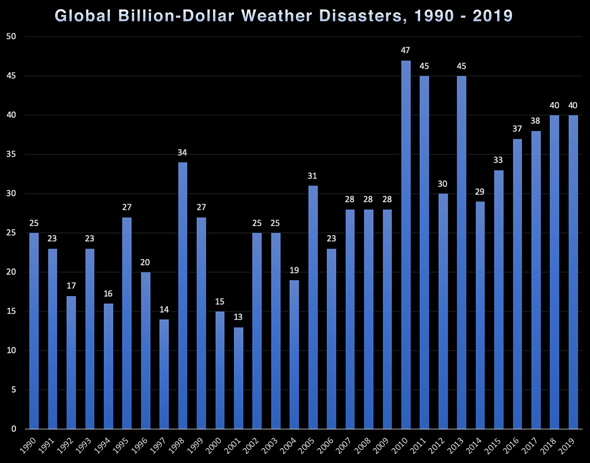
Figure 1. Billion-dollar weather disasters between 1990 – 2019, as cataloged by Aon. Credit: Jeff Masters
On supporting science journalism
If you're enjoying this article, consider supporting our award-winning journalism by subscribing. By purchasing a subscription you are helping to ensure the future of impactful stories about the discoveries and ideas shaping our world today.
Here are 2019’s forty billion-dollar weather disasters, as tabulated by Aon:
Typhoon Hagibis, Japan, 10/6 – 10/12, $15 billion, 99 killed
Flooding, China, Jun - Aug, $15 billion, 300 killed
Hurricane Dorian, 8/25 – 9/7, Bahamas, U.S., Caribbean, Canada, $10 billion, 83+ killed
Typhoon Faxai, Japan, 9/7 – 9/9, $10 billion, 3 killed
Flooding, India, Jun - Oct, $10 billion, 1750 killed
Flooding, Mississippi Basin U.S., May - Jul, $10 billion, 0 killed
Flooding, Missouri Basin U.S., 3/12 – 3/31, $10 billion, 10 killed
Typhoon Lekima, China, Philippines, Japan, Aug 6 - 13, $9.5 billion, 101 killed
Flooding, Iran, Mar - Apr, $8.3 billion, 77 killed
Cyclone Fani, India, Bangladesh, 5/3 – 5/5, $8.1 billion, 89 killed
Drought, China, Jan - Dec, $8 billion
Wildfires, Australia, 11/8 – 12/31, $5 billion, 29 killed
Severe Weather, Rockies, Plains, Midwest U.S., 5/27 – 5/30, $4.5 billion, 0 killed
Tropical Storm Imelda, Texas/Louisiana (U.S.), 9/17 – 9/20, $3.5 billion, 5 killed
Flooding, Italy and Austria, 11/11 – 11/19, $3.5 billion, 3 killed
Cyclone Bulbul, India and Bangladesh, 11/8 – 11/11, $3.4 billion, 72 killed
Severe Weather, Plains, Southeast U.S., 10/20 – 10/21, $2.75 billion, 4 killed
Cyclone Idai, Mozambique, Zimbabwe, Malawi, 3/3 - 3/18, $2.7 billion, 1303 killed
Flooding, Spain, 9/11 – 9/15, $2.5 billion, 7 killed
Flooding, Argentina, Uruguay, 1/1 - 1/20, $2.3 billion, 5 killed
Flooding, China, 8/18 – 8/21, $2.3 billion, 45 killed
Drought, Chile, Jan - Dec, $2 billion
Flooding, Australia, 1/28 - 2/7, $1.9 billion, 3 killed
Severe Weather, Plains, Midwest U.S., 3/23 – 3/25, $1.8 billion, 0 killed
Drought, India, Jan - Dec, $1.75 billion
Drought & Heatwave, Western & Central Europe, Jun - Aug, $1.7 billion, N/A killed
Drought, Spain, Jan - Dec, $1.7 billion
Windstorm Eberhard, Central & Western Europe, 3/10, $1.6 billion, 2 killed
Severe Weather, Plains, Midwest, Southeast U.S., 5/4 – 5/10, $1.5 billion, 1 killed
Drought, U.S., Jan - Dec, $1.5 billion, 0 killed
Drought, Australia, Jan - Dec, $1.4 billion
Severe Weather, Central/Eastern U.S., 2/22 - 2/26, $1.4 billion, 4 killed
Severe Weather, Plains, Midwest, Southeast, Northeast U.S., 4/12 – 4/15, $1.3 billion, 9 killed
Flooding, Italy and France, 11/21 – 11/24, $1.2 billion, 9 killed
Flooding, Indonesia, 12/31 – 1/3, $1.15 billion, 30 killed
Severe Weather, Rockies, Plains, U.S., 7/4 – 7/5, $1.1 billion, 0 killed
Severe Weather, Central Europe, 6/10 – 6/12, $1.1 billion, 0 killed
Drought, Uruguay, Jan - Dec, $1.1 billion
Severe Weather, Plains, Midwest, Southeast U.S., 3/12 – 3/17, $1 billion, 5 killed
Severe Weather, Plains, Midwest U.S., 5/16 – 5/17, $1 billion, 0 killed
Approximately 11,000 people died in natural disasters in 2019, which ranked among the ten years with the lowest number of disaster-related deaths since 1950. The deadliest natural disaster of 2019 was the monsoon flooding in India, which killed an estimated 1750 people.
Two weather disasters in 2019 were tied for being the most expensive disasters of the year, with $15 billion in damages: Typhoon Hagibis in Japan, and summer monsoon floods in China. These disasters were tied for 13th place in the list of most expensive non-U.S. weather disasters on record (Figure 2).
Eight billion-dollar droughts hit Earth in 2019, the highest number on record. The previous record was seven, set in 2018. Total damages from drought in 2019 were $23 billion, ranking as the 12th highest year for drought losses since 1975.
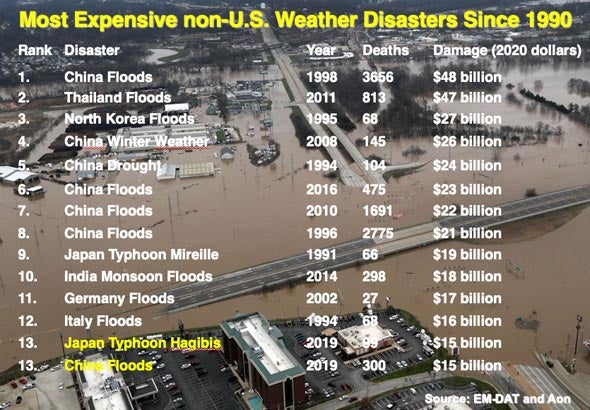
Figure 2. Most expensive non-U.S. weather disasters since 1990. Two disasters from 2019 were tied for 13th place. Data for 1990 – 2018 is from EM-DAT; data for 2019 is from Aon. Credit: Missouri National Guard (background image). The appearance of U.S. Department of Defense (DoD) visual information does not imply or constitute DoD endorsement.
Seven nations or territories see their costliest weather disasters in history
By comparing the Aon Benfield numbers to historical disaster costs at EM-DAT, the International Disaster Database, we see that at least seven nations or territories set records for their all-time most expensive weather-related disaster in 2019. For comparison, two nations had their most expensive weather-related natural disasters in history in 2018, three did so in 2017, four in 2016, and nine in 2015. Here are the nations that set records in 2019 for their most expensive weather-related disaster in history:
The Bahamas suffered almost $8 billion in damage (66% of their $12 billion GDP) from Hurricane Dorian in 2019. Their previous most expensive disaster was $1.3 billion (2019 dollars) from Hurricane Frances of 2004.
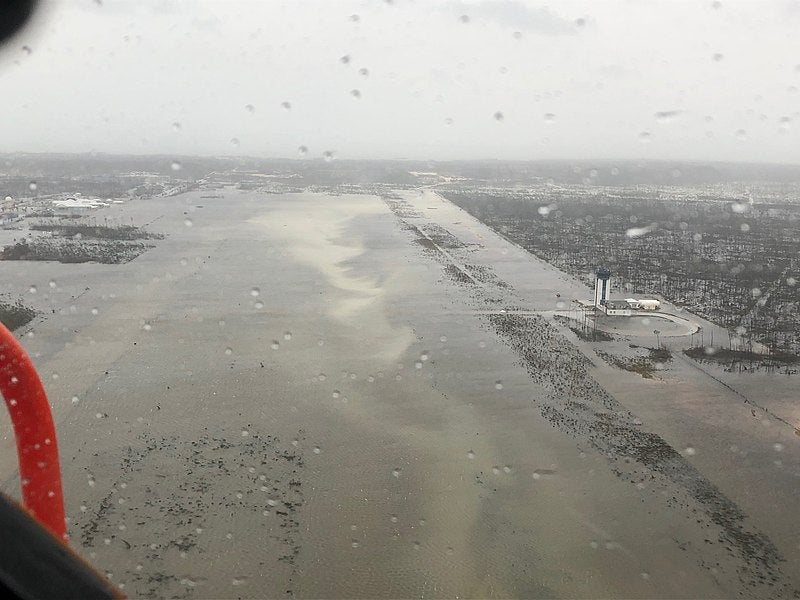
Figure 3. Marsh Harbour Airport on Abaco Island in The Bahamas following devastation by Hurricane Dorian on September 2, 2019. Credit: U.S. Coast Guard District 7 PADET Jacksonville
Mozambique suffered $2 billion in damage (16% of GDP) from Tropical Cyclone Idai, which made landfall on March 14, 2019 as a Category 2 storm with 110 mph winds just north of Mozambique’s fourth-most populated city, Beira (population 530,000). Idai was the most expensive weather-related disaster in African history, according to EM-DAT. The previous record was $1.9 billion in damage from a South African drought during 1991 – 1992. Mozambique’s previous most expensive disaster was $640 million (2019 dollars) from Tropical Cyclone Eline of 2000. Idai killed 602 people in Mozambique, making it their third deadliest weather disaster on record, behind the 100,000 people killed in the 1981 drought and the 800 deaths from Tropical Cyclone Eline of 2000.
Zimbabwe suffered $622 million in damage (3.4% of GDP) from Tropical Cyclone Idai, which stalled over the Mozambique-Zimbabwe border for multiple days, bringing torrential rains. Zimbabwe’s previous most expensive disaster was $560 million (2019 dollars) from a 2013 drought. Idai was also Zimbabwe’s deadliest weather-related disaster on record; the 299 deaths from the storm surpassed the 251 deaths from Tropical Cyclone Dineo of 2017.
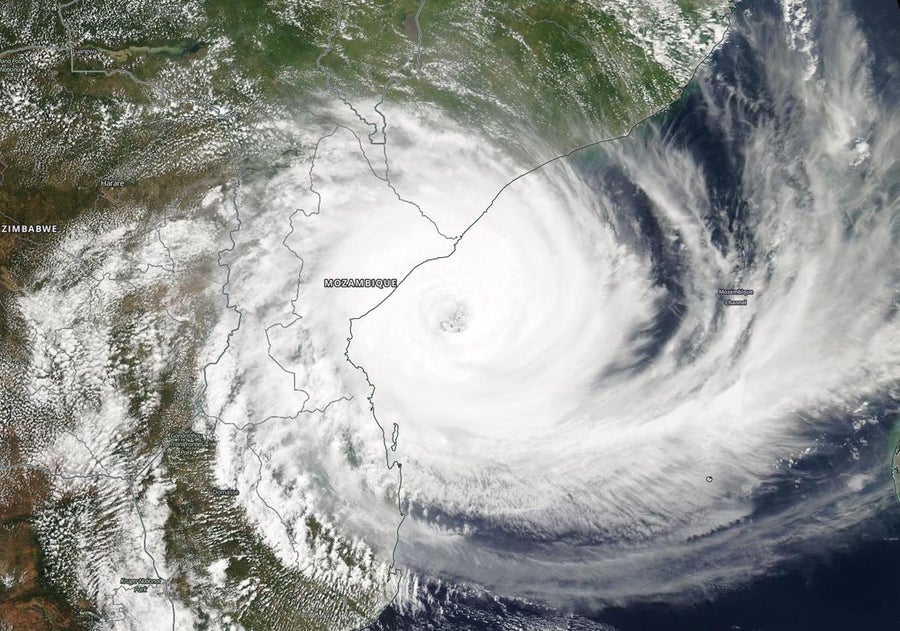
Figure 4. Tropical Cyclone Idai as seen by the VIIRS instrument on the Suomi satellite on March 14, 2019. At the time, Idai was a high-end category 2 storm with 110 mph winds, and was nearing landfall near Beira, Mozambique. Credit: NASA
Iran: Weeks of torrential rains in Iran in March 2019 caused record flooding that killed 77 people and caused $8.3 billion in damage (1.9% of GDP). According to EM-DAT, this ranks as the most expensive flood in Iranian history, ahead of the $5.4 billion damage (2019 dollars) wrought by the floods of April - June 1992. The death toll of the 2019 floods ranks as the 18th deadliest flood in Iranian history. Flooding damaged or destroyed 85,000 homes, and inundated vast amounts of agricultural land and more than 1,900 cities and villages.
Angola experienced intense drought conditions in 2019 that left 2.3 million people food-insecure and caused $600 million in damage (0.5% of GDP). Historical disaster data from Angola is unreliable, but EM-DAT has no records of any previous natural disaster ever exceeding $10 million in damages.
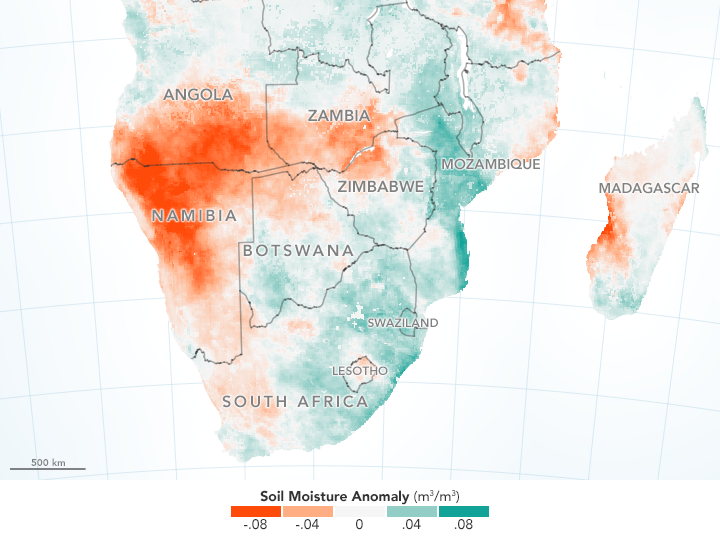
Figure 5. Soil moisture anomalies in February 2019; that is, areas that had more (green) or less (red) water in the upper layers of the ground than the norm for the month. Namibia and southern Angola had especially dry soils. In contrast, soil moisture in Botswana and South Africa appear to be above normal, but arrived too late for much of the region’s maize crops. Credit: NASA
The Azores Islands (territory of Portugal) experienced $365 million in damage (5% of GDP)--primarily to port infrastructure—after Hurricane Lorenzo passed 55 miles north of Flores Island on October 2 as a Category 1 hurricane with 90 mph winds. According to EM-DAT and National Hurricane Center storm summaries, there are no records of any other hurricane causing significant damage in the Azores.
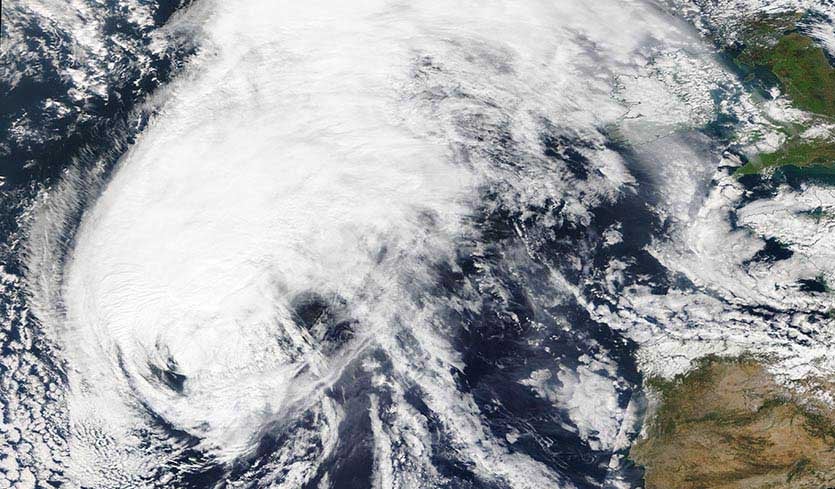
Figure 6. Hurricane Lorenzo as seen by the MODIS instrument on NASA’s Terra satellite on October 2, 2019. At the time, Lorenzo was battering the Azores Islands with Category 1-strength winds of 80 mph. Ireland and the UK are visible at upper right. Credit: NASA
U.S. sees fourteen billion-dollar weather disasters
In the U.S., there were fourteen billion-dollar weather disasters in 2019 according to both Aon and NOAA. This was tied for the fourth-highest total on record, behind the 16 recorded in 2017 and in 2011, and the 15 in 2016. The 1980–2019 annual inflation-adjusted average is 6.5 events, but over the past five years (2015–2019), this number has more than doubled, to 13.8 events. Billion-dollar events account for roughly 80% of the total U.S. losses for all weather-related disasters.
NOAA stated that the number and cost of disasters are increasing over time due to a combination of increased exposure (i.e., values at risk of possible loss), vulnerability (i.e., how much damage does the intensity (wind speed, flood depth) at a location cause) and that climate change is increasing the frequency of some types of extremes that lead to billion-dollar disasters.

Figure 7. U.S. weather disasters costing at least $1 billion in 2019. Credit: NOAA
Weather whiplash award for 2019: Argentina
In a warmer world, “weather whiplash”—experiencing extreme drought and flooding events in rapid sequence—will increase. This occurs because a warmer atmosphere increases drought intensity by drying out vegetation, and also increases heavy rainfall events, since a warmer atmosphere can hold more moisture.
The extreme weather whiplash award for 2019 goes to Argentina. After experiencing a devastating drought in 2018 that cost $3.4 billion (0.5% of GDP)--their most expensive weather-related disaster in history—Argentina was hit by torrential rains in January 2019 that cost $2.3 billion. The floods were Argentina’s third most expensive weather disaster on record, behind the drought of 2018 and floods in 1985 that cost $3.1 billion (2019 dollars).